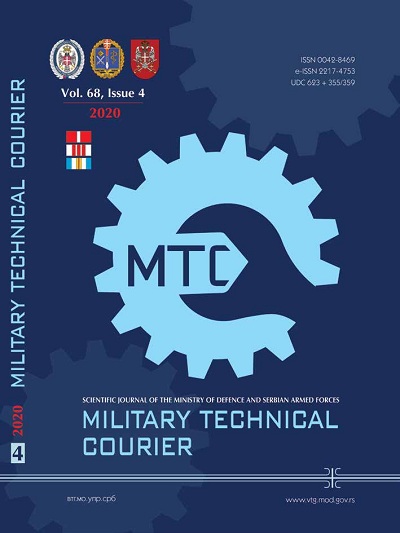Advance in ultrasonic spray pyrolysis (USP) for the synthesis of gold nanoparticles
Abstract
Introduction/purpose: Ultrasonic spray pyrolysis (USP) is usually used for the preparation of submicronic and nanosized gold powders. This is a simple method for a synthesis from an aerosol containing dissolved metallic salts such as gold chloride, gold nitrate, and gold-acetate, obtained in the ultrasonic field using frequencies ranging from 0.8 to 2.5 MHz.
Methods: The USP method combines aerosol formation in an ultrasonic field, transport of an aerosol with a carrier gas to the reactor and final reduction of HAuCl4 with a used gas such as hydrogen and carbon monoxide. The thermal decomposition of gold acetate takes place in a neutral atmosphere such as nitrogen and argon at elevated temperatures. The chemical reduction of HAuCl4 takes place in the aqueous phase using sodium citrate and sodium boride after heating water solution.
Results: Powders of gold were obtained at room temperature using hydrogen reduction in an ultrasonic field at room temperature from HAuCl4 using a frequency of 0.8 MHz. The obtained gold particles were analysed using scanning electron microscopy (SEM) and energy disperse spectroscopy (EDS). The formed particles are round and agglomerated. An increase in temperature to 260°C and 500°C leads to the formation of spherical and cylindrical gold particles.
Conclusion: New improved equipment for an ultrasonic spray pyrolysis synthesis of gold powder from HAuCl4 with hydrogen reduction was offered by PRIZMA, Kragujevac, Serbia, enabling a controlled reduction process with better prevention of piezo transducers in an ultrasonic field and increased aerosol production and its transport to the reaction furnace.
References
Bond, G. 2008. The early History of Catalysis by Gold. Gold Bulletin, 41(3), pp.235-241. Available at: https://doi.org/10.1007/BF03214875.
Corti, C. 2002. Recovery and refining of gold jewelry scraps and waste. In: The Santa Fe Symposium - The Premier Conference For Jewelry Makers, Albuquerque, NM, pp.111-130 [online]. Available at: http://www.santafesymposium.org/2002-santa-fe-symposium-papers/2002-recovery-and-refining-of-gold-jewellery-scraps-and-wastes [Accessed: 10 August 2020].
Dittrich, R., Stopic, S. & Friedrich, B. 2011. Mechanism of nanogold formation by ultrasonic spray pyrolysis. In: Proceeding of EMC 2011 - European Metallurgical Conference, Duesseldorf, June 26-29, pp.1065-1076 [online]. Available at: http://www.metallurgie.rwth-aachen.de/new/images/pages/publikationen/emc2011_id_5231.pdf [Accessed: 10 August 2020].
Kozhukharov, S. & Tchaoushev, S. 2013. Spray pyrolysis equipment for various application. Journal of Chemical Technology and Metallurgy, 48, pp.111-118 [online]. Available at: https://www.researchgate.net/publication/283826563_Spray_pyrolysis_equipment_for_various_applications [Accessed: 10 August 2020].
Piret, N.L., Hopper, M. & Kudelka, H. 1977. Process for recovering silver and gold from chloride solutions. US Patent number 4131454 [online]. Available at: https://patents.google.com/patent/US4131454A/en [Accessed: 10 August 2020].
Polte, J., Ahner, T.T., Delissen, F., Sokolov, S., Emmerling, F., Thünemann, A.F. & Kraehnert, R. 2010. Mechanism of Gold Nanoparticle Formation in the Classical Citrate Synthesis Method Derived from Coupled In Situ XANES and SAXS Evaluation. Journal of the American Chemical Society, 132(4), pp.1296-1301. Available at: https://doi.org/10.1021/ja906506j.
Qi, C. 2008. The production of propylene oxide over nanometer Au catalysts in the presence of H2 and O2. Gold Bulletin, 41(3), pp.224-234. Available at: https://doi.org/10.1007/BF03214874.
Rudolf, R., Friedrich, B., Stopić, S., Anžel, I., Tomić, S. & Čolić, M. 2012. Cytotoxicity of Gold Nanoparticles Prepared by Ultrasonic Spray Pyrolysis. Journal of Biomaterials Applications, 26(5), pp.595-612. Available at: https://doi.org/10.1177/0885328210377536.
Schmid, G. & Corain, B. 2003. Nanoparticulated Gold: Syntheses, Structures, Electronics, and Reactivities. European Journal of Inorganic Chemistry, 2003(17), pp.3081-3098. Available at: https://doi.org/10.1002/ejic.200300187.
Stopic, S, Rudolf, R., Bogovic, J., Majerič, P., Čolić, M., Tomić, S., Jenko, M. & Friedrich, B. 2013. Synthesis of Au nanoparticles prepared with ultrasonic spray pyrolysis and hydrogen reduction. Materials and Technology, 47(5), pp.577-583 [online]. Available at: http://mit.imt.si/izvodi/mit135/stopic.pdf [Accessed: 10 August 2020].
Tréguer-Delapierre, M., Majimel, J., Mornet, S., Duguet, E. & Ravaine, S. 2008. Synthesis of non-spherical gold nanoparticles. Gold Bulletin, 41(2), pp.195-207. Available at: https://doi.org/10.1007/BF03216597.
Turkevich, J., Stevenson, P.C. & Hillier, J. 1953. The Formation of Colloidal Gold. The Journal of Physical Chemistry, 57(7), pp.670-673. Available at: https://doi.org/10.1021/j150508a015.
Young, J.K., Lewinski, N.A., Langsner, R.J., Kennedy, L.C., Satyanarayan, A., Nammalvar, V., Lin, A.Y. & Drezek, R.A. 2011. Size-controlled synthesis of monodispersed gold nanoparticles via carbon monoxide gas reduction. Nanoscale Research Letters, 6(art.numb.428). Available at: https://doi.org/10.1186/1556-276X-6-428.
Watzky, M.A. & Finke, R.G. 1997. ransition Metal Nanocluster Formation Kinetic and Mechanistic Studies. A New Mechanism When Hydrogen Is the Reductant: Slow, Continuous Nucleation and Fast Autocatalytic Surface Growth. Journal of the American Chemical Society, 119(43), pp.10382-10400. Available at: https://doi.org/10.1021/ja9705102.
Proposed Creative Commons Copyright Notices
Proposed Policy for Military Technical Courier (Journals That Offer Open Access)
Authors who publish with this journal agree to the following terms:
Authors retain copyright and grant the journal right of first publication with the work simultaneously licensed under a Creative Commons Attribution License that allows others to share the work with an acknowledgement of the work's authorship and initial publication in this journal.
- Authors are able to enter into separate, additional contractual arrangements for the non-exclusive distribution of the journal's published version of the work (e.g., post it to an institutional repository or publish it in a book), with an acknowledgement of its initial publication in this journal.
- Authors are permitted and encouraged to post their work online (e.g., in institutional repositories or on their website) prior to and during the submission process, as it can lead to productive exchanges, as well as earlier and greater citation of published work (See The Effect of Open Access).

